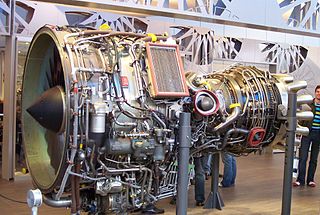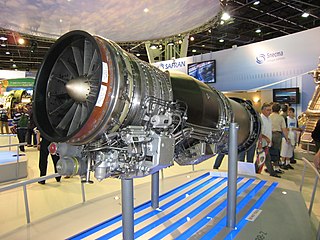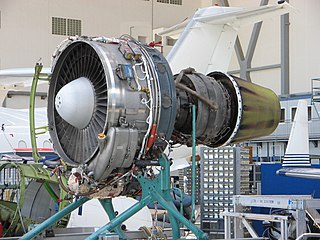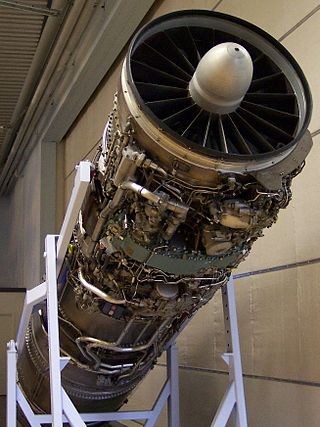Related Research Articles

The turbofan or fanjet is a type of airbreathing jet engine that is widely used in aircraft propulsion. The word "turbofan" is a portmanteau of "turbine" and "fan": the turbo portion refers to a gas turbine engine which achieves mechanical energy from combustion, and the fan, a ducted fan that uses the mechanical energy from the gas turbine to force air rearwards. Thus, whereas all the air taken in by a turbojet passes through the combustion chamber and turbines, in a turbofan some of that air bypasses these components. A turbofan thus can be thought of as a turbojet being used to drive a ducted fan, with both of these contributing to the thrust.

The Pratt & Whitney JT9D engine was the first high bypass ratio jet engine to power a wide-body airliner. Its initial application was the Boeing 747-100, the original "Jumbo Jet". It was Pratt & Whitney's first high-bypass-ratio turbofan.

The Pratt & Whitney PW2000, also known by the military designation F117 and initially referred to as the JT10D, is a series of high-bypass turbofan aircraft engines with a thrust range from 37,000 to 43,000 lbf. Built by Pratt & Whitney, they were designed for the Boeing 757. As a 757 powerplant, these engines compete with the Rolls-Royce RB211.

The Pratt & Whitney PW6000 is a high-bypass turbofan jet engine designed for the Airbus A318 with a design thrust range of 18,000–24,000 lbf (80–107 kN).

The Engine Alliance GP7000 is a turbofan jet engine manufactured by Engine Alliance, a joint venture between General Electric and Pratt & Whitney. It is one of the powerplant options available for the Airbus A380, along with the Rolls-Royce Trent 900.

The Europrop International TP400-D6 is an 11,000 shp (8,200 kW) powerplant, developed and produced by Europrop International for the Airbus A400M Atlas military transport aircraft. The TP400 is the most powerful turboprop in service using a single propeller; only the Kuznetsov NK-12 using contra-rotating propellers is larger.

The Pratt & Whitney Canada PW100 aircraft engine family is a series of 1,800 to 5,000 shaft horsepower turboprops manufactured by Pratt & Whitney Canada. Pratt & Whitney Canada dominates the turboprops market with 89% of the turboprop regional airliner installed base in 2016, leading GE Aviation and Allison Engine Company.

The Pratt & Whitney J57 is an axial-flow turbojet engine developed by Pratt & Whitney in the early 1950s. The J57 was the first 10,000 lbf (45 kN) thrust class engine in the United States. The J57/JT3C was developed into the J52 turbojet, the J75/JT4A turbojet, the JT3D/TF33 turbofan, and the XT57 turboprop. The J57 and JT3C saw extensive use on fighter jets, jetliners, and bombers for many decades.

The Rolls-Royce AE 3007 is a turbofan engine produced by Rolls-Royce North America, sharing a common core with the Rolls-Royce T406 and AE 2100. The engine was originally developed by the Allison Engine Company, hence the "AE" in the model number.

The Snecma M88 is a French afterburning turbofan engine developed by Snecma for the Dassault Rafale fighter.

The Pratt & Whitney Canada PW300 series is a family of turbofan jet engines developed by Pratt & Whitney Canada specifically for business jet applications.

The Progress D-27 is a three-shaft propfan engine developed by Ivchenko Progress. The gas generator was designed using experience from the Lotarev D-36 turbofan. The D-27 engine was designed to power more-efficient passenger aircraft such as the abandoned Yakovlev Yak-46 project, and it was chosen for the Antonov An-70 military transport aircraft. As of 2019, the D-27 is the only contra-rotating propfan engine to enter service.

The Lycoming ALF 502/LF 507 is a geared turbofan engine produced by Lycoming Engines, AlliedSignal, and then Honeywell Aerospace.

The Volvo RM8 is a low-bypass afterburning turbofan jet engine developed for the Saab 37 Viggen fighter. An augmented bypass engine was required to give both better fuel consumption at cruise speeds and higher thrust boosting for its short take-off requirement than would be possible using a turbojet. In 1962, the civil Pratt & Whitney JT8D engine, as used for airliners such as the Boeing 727, was chosen as the only engine available which could be modified to meet the Viggen requirements. The RM8 was a licensed-built version of the JT8D, but extensively modified for supersonic speeds, with a Swedish-designed afterburner, and was produced by Svenska Flygmotor.

The Pratt & Whitney/Allison 578-DX was an experimental aircraft engine, a hybrid between a turbofan and a turboprop known as a propfan. The engine was designed in the 1980s to power proposed propfan aircraft such as the Boeing 7J7 and the MD-91 and MD-92 derivatives of the McDonnell Douglas MD-80. As of 2019, it is still one of only four different contra-rotating propfan engines to have flown in service or in flight testing.
The Turbomeca Astafan is a single-spool, variable-pitch turbofan engine developed from the Turbomeca Astazou. Despite successful flight-testing, an efficient, quiet and clean design and some commercial interest, the Astafan never entered series production. The engines were only flown on the Fouga 90 prototype and Turbomeca's two test aircraft.

The Pratt & Whitney Canada PW800 is a turbofan engine in the 10,000–20,000 lbf (44–89 kN) thrust class, under development by Pratt & Whitney Canada. Intended for the regional jet and business jet market, the gear-less PW800 shares a common core with the larger, geared PW1000G. The first variants were certified on February 15, 2015, to power the new Gulfstream G500/G600.
MPC 75 was an aircraft project of the company "MPC Aircraft GmbH" a subsidiary of "Deutsche Airbus". Work on the project was done mainly between 1988 and 1992 in Hamburg, Germany. Predevelopment work was finished, however the project never got the "go ahead" and never made it into full development.
The AECC CJ-1000A is a Chinese high-bypass turbofan jet engine currently in development.

The Kuznetsov NK-93 was a civilian aircraft engine, a hybrid between a turbofan and a turboprop known as a propfan. The engine was also unique in having a separate duct around the contra-rotating propellers, as most other propfans are unducted. Once described in a respected aviation encyclopedia as "potentially the most fuel-efficient aircraft jet engine ever to be tested", the NK-93 was targeted for derivatives of Soviet/Russian airliners such as the Ilyushin Il-96, Tupolev Tu-204, and Tupolev Tu-330. Five in-flight engine tests were conducted on the NK-93 from December 2006 to December 2008.
References
- ↑ MTU's engine projects. West Europe: Aerospace. Science & Technology: Europe (Report). JPRS Report. Vol. JPRS-EST-92-028. Foreign Broadcast Information Service (published 17 September 1992). European Avianews International. June 1992. pp. 19–20.
- ↑ Heckmann, Erhard (June 1992). Germany's aerospace industry's problems, progress. West Europe. Science & Technology: Europe: Recent developments in European aerospace (Report). JPRS Report. Vol. JPRS-EST-92-033. Translated by Foreign Broadcast Information Service (published 30 October 1992). Wehrtechnik. pp. 3–6.
- ↑ MPC Aircraft (November 1990). MPC-75 briefing (PDF) (Report).
- ↑ Sedbon, Gilbert; Moxon, Julian (13–19 March 1991). "DASA lands regional-jet deal" (PDF). Headlines. Flight International . p. 5. ISSN 0015-3710. Archived from the original (PDF) on 11 February 2015.
- ↑ Norris, Guy (27 March – 2 April 1991). "RTF180 viewed for regional jet as MTU reveals engine details" (PDF). Technical: Air Transport. Flight International . p. 19. ISSN 0015-3710. Archived from the original (PDF) on 7 November 2012.
- ↑ Betts, Paul (12–13 June 1993). "Pratt and Whitney joins GE to develop smaller jet engines". Financial Times . No. 32086. Paris, France. p. 1. ISSN 0307-1766.
- ↑ Deutsche Airbus GmbH (22 July 1992). Regioliner R92 aircraft definition note (PDF) (Report). Hamburg, Germany. pp. 4–10, 4–11, 4–14.